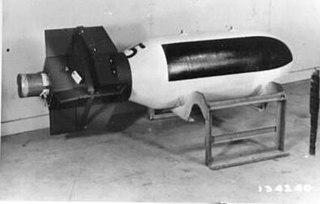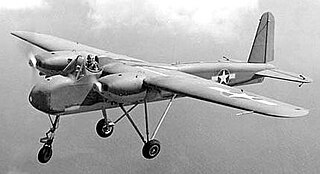
AZON, from "azimuth only", was one of the world's first guided weapons, deployed by the Allies and contemporary with the German Fritz X.

The ASM-N-2 Bat was a United States Navy World War II radar-guided glide bomb which was used in combat beginning in April 1944. It was developed and overseen by a unit within the National Bureau of Standards with assistance from the Navy's Bureau of Ordnance, the Massachusetts Institute of Technology, and Bell Telephone Laboratories. It is considered to be the first fully automated guided missile used in combat.

A guided bomb is a precision-guided munition designed to achieve a smaller circular error probable (CEP).

Project Kingfisher was a weapons-development program initiated by the United States Navy during the latter part of World War II. Intended to provide aircraft and surface ships with the ability to deliver torpedoes to targets from outside the range of defensive armament, six different missile concepts were developed; four were selected for full development programs, but only one reached operational service.

The VB-6 Felix was a precision-guided munition developed by the United States during World War II. It used an infrared seeker to attack targets like blast furnaces or the metal roofs of large factories. The war ended before it could be used operationally.

The LBD-1 Gargoyle was an American air-to-surface missile developed during World War II by McDonnell Aircraft for the United States Navy. One of the precursors of modern anti-ship missiles, it was extensively used as a test vehicle during the late 1940s.
The Fletcher FBT-2 was a military trainer aircraft built in the United States in the early 1940s. Although it was never entered production as a trainer, it was ordered in small numbers as a target drone but when that was cancelled played a small part in the development of guided bombs.

The Fairchild BQ-3, also known as the Model 79, was an early expendable unmanned aerial vehicle – referred to at the time as an "assault drone" – developed by Fairchild Aircraft from the company's AT-21 Gunner advanced trainer during the Second World War for use by the United States Army Air Forces. Two examples of the type were built and flight-tested, but the progress of guided missiles rendered the assault drone quickly obsolete, and the type was not produced.

The Naval Aircraft Factory TDN was an early unmanned combat aerial vehicle - referred to at the time as an "assault drone" - developed by the United States Navy's Naval Aircraft Factory during the Second World War. Developed and tested during 1942 and 1943, the design proved moderately successful, but development of improved drones saw the TDN-1 relegated to second-line duties, and none were used in operational service.

The Bombardment Aircraft Rocket, also known as BOAR, the Bureau of Ordnance Aircraft Rocket, and officially as the 30.5-Inch Rocket, Mark 1, Mod 0, was an unguided air-to-surface rocket developed by the United States Navy's Naval Ordnance Test Station during the 1950s. Intended to provide a standoff nuclear capability for carrier-based aircraft, the rocket entered operational service in 1956, remaining in service until 1963.

The ASM-A-1 Tarzon, also known as VB-13, was a guided bomb developed by the United States Army Air Forces during the late 1940s. Mating the guidance system of the earlier Razon radio-controlled weapon with a British Tallboy 12,000-pound (5,400 kg) bomb, the ASM-A-1 saw brief operational service in the Korean War before being withdrawn from service in 1951.

The GT-1 was an early form of stand-off weaponry developed by the United States Army Air Forces during World War II. Intended to deliver an aerial torpedo at a safe range from the launching aircraft, the weapon proved successful enough in testing to be approved for operational use, and the GT-1 saw limited use in the closing stages of the war.

The JB-4, also known as MX-607, was an early American air-to-surface missile developed by the United States Army Air Forces during World War II. Using television/radio-command guidance, the JB-4 reached the flight-testing stage before being cancelled at the end of the war.

The 1st Experimental Guided Missiles Group is an inactive United States Air Force unit. It was last assigned to the Air Proving Ground Command and stationed at Eglin Air Force Base, Florida. It was inactivated on 22 July 1949.

The AAM-N-5 Meteor was an early American air-to-air missile, developed by the Massachusetts Institute of Technology and Bell Aircraft for the United States Navy. Initially, both air-launched and ship-launched versions were considered. Versions designed for launch from carrier-based aircraft proceeded to the flight testing stage before the project was cancelled.

The LTV-N-4 was an American experimental rocket, developed by the Naval Ordnance Test Station for the development and testing of large solid-fueled rocket boosters for ramjet-powered missiles. Described as "more powerful than the V-2", a number of test flights were conducted during 1949.
Television guidance (TGM) is a type of missile guidance system using a television camera in the missile or glide bomb that sends its signal back to the launch platform. There, a weapons officer or bomb aimer watches the image on a television screen and sends corrections to the missile, typically over a radio control link. Television guidance is not a seeker because it is not automated, although semi-automated systems with autopilots to smooth out the motion are known. They should not be confused with contrast seekers, which also use a television camera but are true automated seeker systems.

The CTV-N-2 Gorgon IIC – also designated KGN, KUN, and CTV-2 – was an experimental drone, originally intended as a surface-to-surface missile, developed by the United States Navy near the end of World War II. It was used to test control and homing systems for guided missiles, and was also produced in small numbers as a target drone under the designations TD3N and KD2N.

Jaguar was a three-stage sounding rocket developed by the United States Air Force in the early 1960s. Designed for air launch to allow soundings from remote areas without infrastructure, it was only launched twice before the project was abandoned.

The Pelican, also known as Bomb Mark 55 and, in one version, SWOD Mark 7, was a guided bomb developed by the United States Navy during World War II. Guided by semi-active radar homing, Pelican was produced in 1,000 lb (450 kg) and 1,500 lb (680 kg) sizes; the program reached the stage of live trials before being cancelled.


















